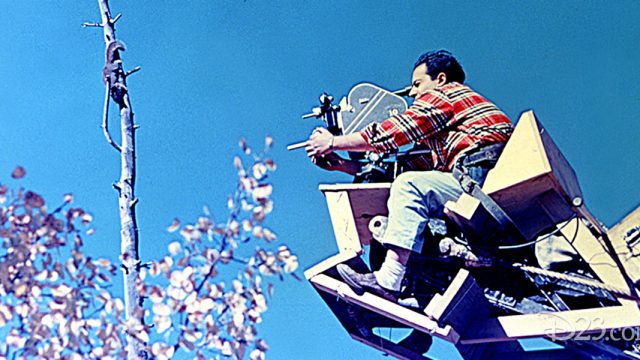Disney has a reputation for sanitizing content. This is doubtless due to things like The Little Mermaid and The Hunchback of Notre Dame, neither of which are as soul-crushing at the end as their source material. And in the original Frog Prince, she doesn’t kiss the frog—she slams him into a wall. This seems to me to be a trend that predates Disney in a lot of ways, stretching back to the first days when children were seen as children and not just small adults. When the idea that you had to protect children from things began. But even leaving that aside, how little Disney product do you have to see in order to notice that Disney doesn’t always hide the truth from kids?
Our film is set in a little glade the film calls Wildwood Heart. We learn that pine squirrels form slightly different family groups; the mother lives in a tree with her young, and the father lives nearby alone. However, a marten sees the mother’s nest; to lure the mother marten away from the young squirrels, the father sacrifices himself. And that’s, I don’t know, five minutes in? Perri’s mother drags the squirrel pups to the father’s nest; Perri is the last one left, and the marten returns before she can be moved. Before the marten kills Perri, however, she notices that a mother raccoon is trying to take the marten kits for her own kits, and the marten returns to her own den. Perri is saved.
So that’s about the first ten minutes of the film. The narration, which is mostly but not entirely in rhyme, informs us “Of course, we must abandon all emotion, all distress, and realize that death is just a necessary end.” Also that the beaver “kills the living aspen tree and dines upon its flesh,” which is a fairly intense way of describing that particular process. A flying squirrel is killed because a sapsucker, searching for grubs in the flying squirrel’s tree, disturbs it and sends it away, and a goshawk sees it, catches it, and eats it. Later, Perri’s mother and siblings are killed while she’s out in the forest in a sequence that is kind of cute.
It’s also the sequence where she meets Bambi; Perri is based on a story by Felix Salter, author of the novel Bambi. This is why, alone of the True-Life Adventure series, this is labeled a “True Life Fantasy.” Yes, yes, I know—not all the True-Life Adventures were passively recording what happened. I’ve already written about the most famous example of that. On the other hand, this is probably the only one where the script knew in advance which animal in a hunting sequence would live and which would die, you know?
The thing is, failings aside, this was a remarkable series of films. This particular installment won the Golden Bear for Best Documentary at the Berlin Film Festival. (It wasn’t even nominated for the Oscar for it, though it was nominated for Best Score and lost to The Bridge on the River Kwai. Only four percent of its footage appears in the finished film, and that’s with a story that actually has a defined beginning, middle, and end. Some of the best wildlife filming has been for this series, regardless of those immigrant Manitoban lemmings.
Apparently, Peri Gilipin is named after the squirrel heroine of this film. Which is an interesting choice on her parents’ behalf, if true. I suppose Perri does survive all sorts of dangers and is full of the spirit of adventure and discovery and so forth, and goodness knows it’s better than all those poor children named Khaleesi and what have you. I’m just not sure I’d tell people, “I was named after a squirrel,” if I were her.
Support my family like Perri’s mom supported her before being eaten; consider contributing to my Patreon or Ko-fi!

